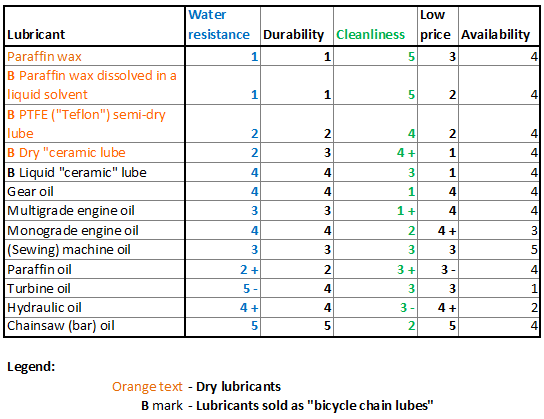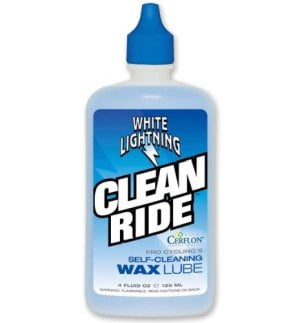This post will offer a comparative overview of bicycle chain lubricants. It will include standard commercialy available lubricants that can be used for lubing bicycle chains, such as chainsaw bar oil, motor oil etc. It will also give comparison of lubricants sold and marketed as bicycle chain lubricants. They will be noted with a “B” letter in Table 1.
Detalined explanation of various lubricants’ characteristics is given in the post:
Bicycle chain lubricants – explained
Criteria upon which comparison is made is the following:
- Resistance to water wash off and rust protection.
- Durability – how long does it take between a re-lubrication is needed.
- Cleanliness – how well does it resist dirt and dust sticking onto the chain.
- Price – how affordable is it.
- Availability – how easy it is to find in small packages
Before the comparison table, a few important notes:
a) Lubricants sold as special bicycle chain lubes vary in price from one manufacturer to the other. They also vary in other criteria (cleanliness, durability etc.). That is why rates for lubricants with “B” mark should be taken with a reserve – they are given as a rough, average estimate.
b) Lubricants noted as dry lubricants, especially those sold as “bicycle chain dry lubes”, are often mixed with a solvent, so they can be easily applied to the chain by dripping, but the solvent evaporates completely after about 4 hours, leaving the chain dry.
c) Characteristics of “wet” (liquid) lubricants depend a lot on the lubricant’s “thickness” (viscosity). One same oil, if it is used thinned (less viscous) will not be as durable, but will attract a lot less dirt – and vice versa. It is explained in detail here. For comparison in this post, ISO VG 40 viscosity grade is compared, but it can be changed according to one’s preferences and riding conditions.
d) Mark 1 means the worst of the compared. For example – the most expensive, or most easily washed off by water etc. Mark 5 means the best of the compared. Mark 3 means somewhere in between the best and the worst, of course. So cleanliness of 5 doesn’t mean a lube doesn’t attract any dirt – just that it is (among) the cleanest of them all. The same applies to all the other criteria. For availability – mark 1 means it’s very hard to find in packages below 20 litres, while mark 5 means it is available in smaller, 100 ml packages and relatively widely available in stores and shops.
e) The comparison is more of a (rough) guide, than carved in stone scientific data. Riding conditions (temperature, rain, dust…), and characteristics of lubes from different manufacturers vary so much, that the only valid method is to test for oneself and see what suits best – according to personal prefferences, budget and needs. So, table 1 provides just a good starting point.
f) Do not use the average mark as a merit, but personal priorities. For example, as can be seen in table 1, chainsaw bar oil has the greatest average mark, but those who value chain cleanliness, or who ride in dry (and dusty) conditions wouldn’t use that for chain lubrication.

Table 1
Update, 2024:
I did an experiment and discussed the pros and cons of both wax, and oil as (bicycle) chain lubricants:
The existing comments posted under this article (questions and answers) have been moved to this BikeGremlin forum thread:
https://www.bikegremlin.net/threads/comparative-overview-of-bicycle-chain-lubricants-article-comments.149/


smoove and squirt are pretty good drip on lubes,both are waxed based and squirt looks like it has ptfe added,most waxed based lubes are among the best lubes on the market but you do need to totally degrease a chain before applying them,some prefer drip on lubes as they are easier to apply than taking chain off bike and dipping it in hot wax,some folk do both,they dip chain in hot wax and then take along a drip on lube with them as well,wax lubes make better sence to me they are much easier to apply and more friendly to your hands and the planet,nothing worse than trying to put a very greasy chain back on the bike